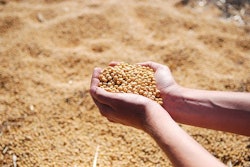
More than 70 nutritionists, purchasing managers and other decision makers attended the South Asia Trade Exchange, jointly organized by the U.S. Grains Council (USGC) and the U.S. Soybean Export Council (USSEC), in Colombo, Sri Lanka, earlier this month.
|
The U.S. Grains Council collaborated with the U.S. Soybean Export Council to conduct the South Asia Trade Exchange in Sri Lanka. |
Attendees from Bangladesh, Sri Lanka, Nepal, Pakistan and India traveled to the meeting to hear expert views on the U.S. production and trading systems. Participants also received the latest market and industry information, including outlooks for the global commodity sectors as well as supply and demand drivers.
“The buyers learned why U.S. feed grains and co-products are valuable to their operations,” said Manuel Sanchez, USGC South & Southeast Asia regional director. “It is not only the grain they purchase, but also a commitment to services that help them confidently use these commodities in their feed rations - a win-win situation for both U.S. farmers and suppliers as well as the end-users here in South Asia.”
Exports of U.S. corn, distiller’s dried grains with solubles (DDGS) and the corn equivalent of meat products to the five countries totaled nearly 520,000 metric tons in 2016/2017. The Council expects this demand potential to grow significantly as the result of new investments and a growing population.
The South Asian region is home to 1.7 billion people with an average economic growth much higher than the world average, exceeding 6.5 percent annually. The region continues to invest in the feed industry as meat consumption grows at a healthy pace, particularly with poultry consumed in all three of the major countries in the region - India, Bangladesh and Sri Lanka. The region also has encouraging new interest in aquaculture.
“Southeast Asia’s macro-economic factors offer significant potential for increasing demand from the livestock sector,” Sanchez said. “This opportunity for growth, combined with the region’s diminishing ability to grow feed grains locally, could lead to significant opportunities for U.S. feed grain and co-product exports to the region.”
第二届会议在斯里兰卡event organized by the Council and USSEC to bring together grain buyers, traders and end-users from across the region with the goal of enhancing understanding of world grain flows and trends as well as facilitating dialogue on how U.S. feed grains and co-products can meet future regional demand. Thefirst conferencebrought together 120 executives from major feed, livestock production and grain trading companies and provided opportunities for decision makers, both importers and exporters, to interact on trade and product issues.
Learn more about the Council’s work in South Asiahere.





















